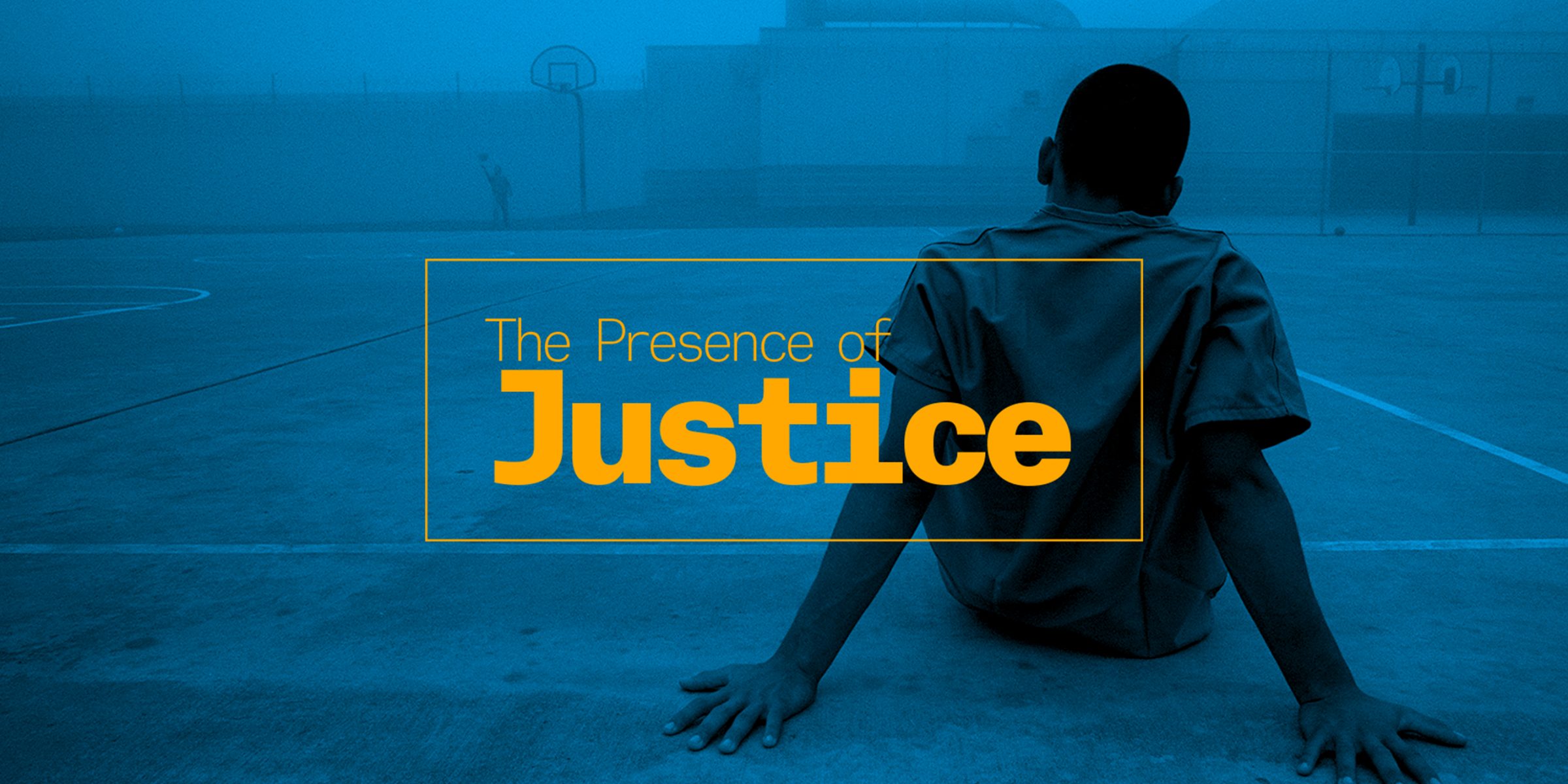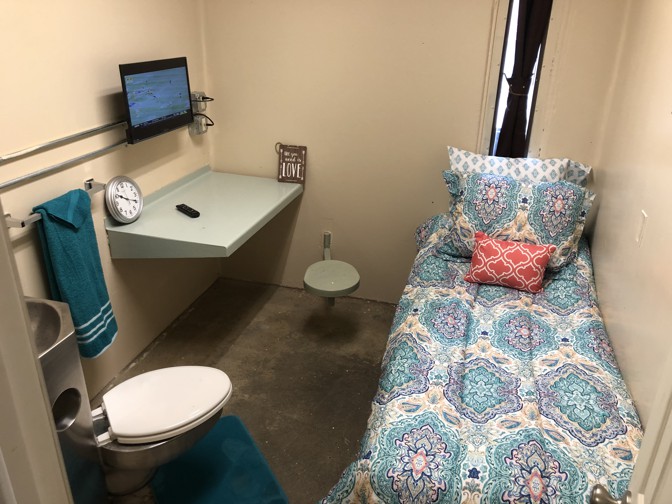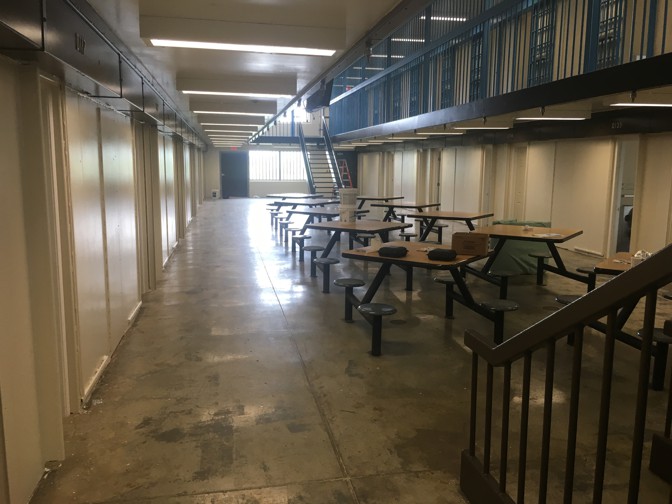The Repurposing of the American Jail

Like many other correctional professionals, Sheriff Craig Apple of Albany County, New York, was initially suspicious of using drugs to treat drug addiction. He was considering the merits of introducing buprenorphine and methadone—two drugs used to treat opioid-use disorder—into the county’s main jail facility, and wasn’t sure he should, given that those drugs can become valuable and dangerous contraband. But over time, Sheriff Apple’s opinion began to shift. Local advocates kept sending him data-based evidence showing that medication-assisted treatment, commonly called MAT, helped people recover from their addiction and reduced crime.
Help a local organization win $40,000 in funding and make an even bigger impact.
So, in 2015, Sheriff Apple got Albany County’s health department to sign off on a plan to treat heroin addiction in his jail. By January of this year, Apple expanded the program to include the full range of MAT, including buprenorphine and methadone. It worked. According to Apple, inmates were receiving proper treatment, so they were healthier and less likely to take illicit drugs. People who had participated in the program in jail before being released, Apple told me, had a 13 percent recidivism rate, compared with 40 percent for inmates not in the program.
Sheriff Apple went on the road to meet with other sheriffs and advocate for better MAT programs within correctional facilities. Back home, he gave the Albany County Correctional Facility a new name—the Albany County Corrections and Rehabilitative Services Center—and brought in nonprofits and non-law-enforcement personnel to provide services. Sheriff Apple also made another, more unusual, change: He converted 25 cells into rooms for people who were homeless, including those struggling with substance-use disorder, whether or not they had been accused of a crime. The move represents a growing—and controversial—trend in the United States as communities struggling with issues such as homelessness and substance-use disorder have begun using detention facilities to house people who haven’t been charged with a crime or sentenced to incarceration.
Apple’s idea, which he calls the Sheriff’s Homeless Improvement Project (SHIP), was not only to provide shelter to Albany’s growing homeless population, but also to grant access to the services available at the jail. He hopes this will reduce recidivism among homeless people who have previously served time (in turn lowering costs): “A lot of these folks get out of jail, and they don’t have a home. They don’t have family. They go from one shelter to another … and then they reoffend, and they are back in jail, and we lose.” Another inspiration, Apple said, was that imminent bail-reform legislation in New York State, which will take effect in January, means that he, like other sheriffs, has a “huge jail with a low census”—that is, a lot of empty space to fill. The program hopes to begin accepting participants around the end of November. “We are taking a bad building and making something good out of it,” he explained.

The newly converted cells are not intended to feel punitive. They have doors instead of bars, and amenities such as televisions, and residents can move in and out of their rooms freely. Sheriff Apple said in a phone conversation that the new program is “not a jail,” but more like a drop-in center. “You don’t like it, go do whatever you’ve got to do,” he said when asked whether people can drop out anytime.
While it’s too soon to tell what the outcome will be, Apple’s plan reflects the growing tension between law-enforcement officials and advocates for people with substance-use disorder who believe that drug problems should be managed within communities, not in correctional facilities. (Apple is adamant that SHIP is not a correctional program.) Critics ask, even if people like Sheriff Apple have the best of intentions, should communities rely on law enforcement to lead the response to the substance-use-disorder crisis?

Deaths from drug overdoses have been steadily increasing over the past two decades. In 2017, drug overdoses accounted for more than 70,000 deaths in the U.S.; opioid-related deaths, in particular, accounted for nearly 48,000 of those. Preliminary data for 2018 show a slight downturn so far, though overdose deaths are still much higher than they were 20 years ago. They have contributed to lowering life expectancy in the United States three years in a row—something that hadn’t previously happened in a century, when the U.S. population plummeted because of World War I and a flu pandemic.
One result of the opioid crisis has been the proliferation of treatment within correctional facilities. In October 2018, the National Sheriffs’ Association published a guide that supported the use of jail-based MAT treatment protocols. Communities have invested in treatment for those entering the criminal-justice system through programs such as drug courts and pretrial diversion.
But while jails have increased services for inmates, other community members with substance-use disorder often struggle to find resources they can afford, especially in states that have not expanded Medicaid under the Affordable Care Act. Many rural areas have no treatment providers for miles. Families worry about how to help their loved ones, and with nowhere else to turn, they look to law enforcement. Local correctional authorities have seized on the public momentum, advocating for treatment in locked facilities as a kind of public-health response.
In Massachusetts, a state statute, Section 35, allows family members, law enforcement, and physicians to petition the state to involuntarily commit someone for substance-use-disorder treatment, in some cases in jail or prison. During the past fiscal year, according to NPR, 6,500 people were incarcerated under Section 35, which represents a significant increase from previous years.
In one state-run, prison-style facility in Plymouth, Massachusetts, a young man incarcerated for treatment under Section 35 died from suicide. A pending lawsuit against the Massachusetts Department of Correction and Department of Public Health brought in March by the Prisoners’ Legal Services of Massachusetts argued that putting Section 35 people in jail-like settings for treatment violates the Americans with Disabilities Act, among other laws. The lawsuit claims that people confined in the Plymouth facility under Section 35 are subject to solitary confinement as punishment, wear state-issued clothing, and are chased with helicopters and dogs if they try to leave without permission from a judge. (A spokesman from the Massachusetts Department of Correction said the department does not comment on pending litigation.) Legislation proposed in January would outlaw the use of prisons and jails as treatment facilities in Massachusetts.
Still, correctional officials defend jail- and prison-based treatment, even in the face of controversy. Last year, Sheriff Nick Cocchi of Hampden County, Massachusetts, announced that a wing of the county jail would be reserved for Section 35 detainees. These lockups, renamed “treatment centers,” are housed inside the main jail and provide access to rehabilitative programs. But the approximately 100 people in the program are kept separate from regular jail inmates and, according to Cocchi’s office, have more freedom to move about the facility.
Judges and others have praised Cocchi’s program in Hampden County, particularly for its role helping those in rural communities where services are scarce. In addition to touting the health benefits of the program, Cocchi has repeatedly noted, as an advantage, that he has filled unused jail beds. People who enter the program stay an average of 48 days, longer than patients can stay in private facilities. And unlike in other treatment programs, those in Cocchi’s program receive assistance reintegrating into society and resolving any open arrest warrants or criminal charges. Robert Rizzuto, a spokesman for the sheriff’s office, said, “Unlike other facilities, we help people through each stage of the recovery process. We don’t want to leave someone to figure things out on their own.” The state has added $1 million to the program’s budget for the next fiscal year, Rizzuto said.
But public-health experts and advocates largely oppose programs such as Cocchi’s. Bonnie Tenneriello, a staff attorney at Prisoners’ Legal Services of Massachusetts who has worked on the Section 35 lawsuit for years, told me that as prison and jail populations dwindle, officials may increasingly repurpose the space.
Leo Beletsky, a professor of law and health sciences at Northeastern School of Law and the faculty director for the Health in Justice Action Lab, argues that civil commitment is just a rebranding of incarceration. Beletsky, along with his colleague Denise Tomasini-Joshi, wrote in an op-ed for The New York Times that it is “clear how harmful it is for the health of patients—and public discourse—to describe detention in correctional facilities as ‘treatment.’”
Dionna King, a policy manager at the New York office of the Drug Policy Alliance, a group that seeks to reduce the criminalization of substance abuse, has vigorously argued that using locked facilities as treatment centers violates the rights of people with substance-use disorder. “Using tools of confinement and containment to remove people from their day-to-day life—that’s punishment,” she said.
King and Beletsky believe that jails are not adequate health-care facilities. They note that research indicates that people who spend time in jail have worse health across the board, and that evidence suggests involuntary treatment for substance-use disorder may not be effective in the long run. “Any period of incarceration impacts health long-term,” King said in a phone interview.
Others have suggested that it might be a violation of civil liberties to detain people for treatment. Alexander Shalom, an attorney for the American Civil Liberties Union of New Jersey, said, “The criminal legal system doesn’t get to dictate what people do if they haven’t committed a crime.”
In lieu of pursuing custodial treatment, King and Beletsky recommend that more counties look at new models like one in Rhode Island, where authorities have integrated MAT into reentry programs that help people leave jail and return to their communities, where they can work and be with their families while they are in recovery.
Rizzuto, the spokesman for Sheriff Cocchi in Massachusetts, said in an email, “We believe there are many paths to recovery and there is no wrong one. Section 35 is typically not a first option for treatment but rather a last resort when other options haven’t worked and a loved one is dangerously close to causing serious harm to someone else or dying.”
Sheriff Apple said, “No one else is doing anything to help these people. Maybe you don’t like the way we are doing it … but I can go to sleep at night.”
Opponents of jail-based treatment acknowledge that people who seek to detain their loved ones for treatment, or those who check themselves into treatment centers located in jails, often do so out of a lack of options. “There’s an anxiety from loved ones when they have exhausted options or don’t know them,” King said. Instead of forcing people to turn to these kinds of facilities, she said, communities should give them better options outside jails. And families worried about their loved ones should also consider that people who use drugs should ultimately have a say over how they are treated. “There’s an idea that people who use drugs are not capable of rational decisions, so we want to remove choices from these people,” she said. But, she added, treating substance-use disorder doesn’t need to involve force: “There are different ways to change.”
This article is part of our project “The Presence of Justice,” which is supported by a grant from the John D. and Catherine T. MacArthur Foundation’s Safety and Justice Challenge.
We want to hear what you think about this article. Submit a letter to the editor or write to letters@theatlantic.com.
 Pathways Drug Rehabilitation Luxury Addiction Treatment & Detox Center
Pathways Drug Rehabilitation Luxury Addiction Treatment & Detox Center


